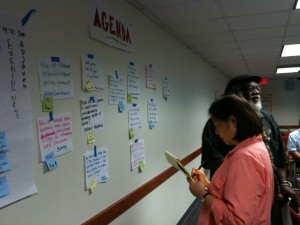
Linda Jue, founding director and executive editor of the G.W. Williams Center for Independent Journalism, examines the agenda wall at the JTM Create or Die 2 event in Greensboro in June 2011.
In search of the larger picture of media entrepreneurship, I recently traveled from North Carolina to Washington, DC and environs to meet with incubator directors, serial entrepreneurs, and others in the digital intelligencia. My goal, I thought, was simple. Engage in conversations about the new media landscape and how to fund great ideas.
Admittedly, I went with my own preconceived notions on what I’ve dubbed the East Coast Listening Tour. I was thinking of creating an accelerator to help educate and fund journalism-based projects coming out of the Journalism That Matters Create or Die series of design | build | pitch events in Detroit and Greensboro.
But something shifted on that road trip. Perhaps, like in the movies, my character learns something about herself as she traveled down the highways. As I met with folks like Doug Mitchell, co-director of UNITY’s New U incubator and William Crowder, managing director of the Comcast DreamIt Ventures project and Dr. Chad Womack, cofounder of the Black Innovation and Competitiveness Initiative, I stopped thinking and talking. I put on my journalism hat. And I started asking questions and listening.
What is needed in the media entrepreneurship space for projects by and for people of color? What do project teams need in terms of education, training or funding? When do they need such interventions? Who is already servicing these people with the skills and knowledge to be successful? What is the audience that is not being served effectively?
Many on the National Association of Black Journalists Digital Journalism Task Force have talked about the lack of financing for journalism projects by or for people of color. New U was designed to help address that gap. DreamIt Ventures was designed to fill that need. But as I chatted with people just as passionate about media entrepreneurship, the larger media ecosystem became a bit clearer. And the gaping holes became increasingly apparent.
With more than 200 applicants for 16 slots in the 2010 class, New U has a very selective process for picking its final teams for mentoring. Four of the 16 go on to actual funding. Same scenario with DreamIt Ventures. Many more entrepreneurs are waiting for their shot than the number of slots available to accommodate them.
Venture capitalists talk about deal flow…the number of ideas it takes for the big one to be found. To me, it doesn’t seem as if we have any problem with deal flow with the hundreds of entrepreneurs of color waiting for a chance to be heard. What I see is a tremendous narrowing of the arteries leading to the heart of the matter – funding. And lots of ideas never see the light of day for lack of access to that flow.
Dr. Michelle Ferrier is chief instigator for the Journalism That Matters Create or Die series, She is the founder and publisher of LocallyGrownNews.com, a hyperlocal community news site now in its second year. She is also an associate professor in the School of Communications at Elon University.